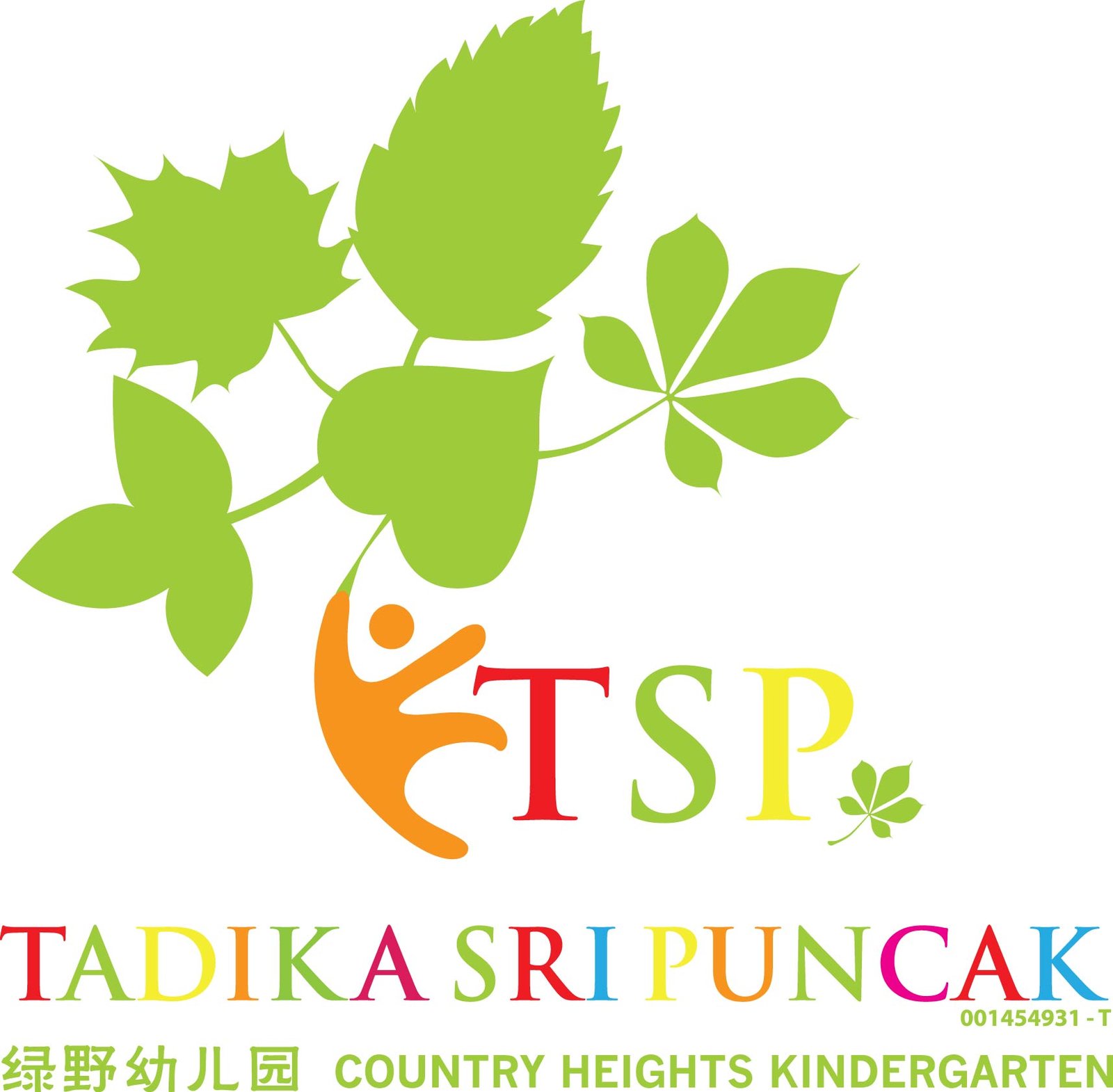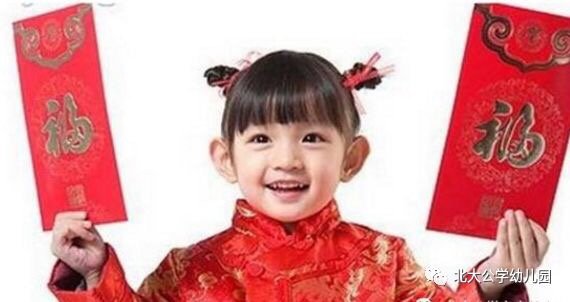
by Sophie Lee 李淑儀 | Feb 16, 2018 | Parenting
 团圆是春节的主题,无论相隔多远的距离,亲朋好友都会团聚在一起,在这个节日里,我们的宝贝会接触到很多的亲朋好友,而幼儿的社会性礼仪发展,正是在人与人之间相互沟通和交流中建立起来的,所以,不妨利用春节假期,对孩子进行一场“静悄悄”的礼仪教育,让孩子在潜移默化中获得成长。
团圆是春节的主题,无论相隔多远的距离,亲朋好友都会团聚在一起,在这个节日里,我们的宝贝会接触到很多的亲朋好友,而幼儿的社会性礼仪发展,正是在人与人之间相互沟通和交流中建立起来的,所以,不妨利用春节假期,对孩子进行一场“静悄悄”的礼仪教育,让孩子在潜移默化中获得成长。
访友礼仪
1、孩子在进入他人家中时需要更换室内拖鞋,家长可以示范给孩子看,主动将更换完的鞋子摆放整齐,给孩子树立整理意识。
2、主动称呼他人,这是常规性礼仪,家长可以事先在家和孩子一起模拟训练,提前告知孩子将会见到那些亲朋,避免现场见面孩子不配合,引起不必要的尴尬,同时也让孩子知道,任何时候称呼他人,是我们尊重他人的第一步。
3、双手接受物品,不当面拆开红包。新年拜年,长辈会给晚辈准备礼物或者是红包,很多孩子看见喜欢的东西会开心,但是不喜欢的甚至都不看一眼,给他人造成尴尬,家长可以引导孩子双手接纳,并感谢他人,可提前引导孩子换位思考,别人为我们准备礼物,是花费了心思,如果我们不接纳,他们会伤心的,红包接受,可以交给父母保管。
4、不随意跑动、打闹。由于过年亲朋集聚,会导致空间较为狭小,但是孩子之间的相处,会出现跑动、打闹的情景,一方面会导致碰损他人家长物品,另一方面会造成环境的混乱,家长可以引导孩子在一旁玩耍,切忌呵斥孩子,给予孩子尊重。
5、没有允许,不翻动他人的物品。在一个新的空间,会激发孩子的探索欲望,当孩子表现出这样的欲望时,家长不要一味的压抑孩子想法,反而会激发孩子探索欲,家长可以陪同孩子一起询问主人意见,再去打开物品,告知孩子不能随意翻动。
6、长辈先落座,夹菜有礼貌。现在孩子独生子女较多,过年餐桌上有很多的好吃的,孩子可能菜品刚刚端上来,就迫不及待的坐上板凳,用手夹菜,这时候,我们可以寻找一个身边有礼貌的孩子做示范,鼓励孩子向他学习,邀请长辈先落座,自己再坐下,有想吃的菜品,请父母帮忙夹菜。
7、好吃的食物,不独享,分享给他人。幼儿社会认知有限,看见比较喜爱的食物,可能会想一个人“占有”,因此在日常生活中,家长应该逐渐渗透分享理念,甚至可以演一场戏,让孩子体验不被分享的失落。
8、卫生用餐。春节孩子在一起嬉戏,小手可能会弄得脏兮兮的,稍不留神,细菌进入肚子,引起不适,家长主动带孩子在饭前便后洗手,提醒幼儿使用餐具饮食。
待客礼仪
1、礼仪用语我会说。过年家中来了客人,家长要引导孩子主动打招呼,使用“您好”、“请”、“谢谢”、“下次再来玩哦”……等等人际交往常用语,同时,新年新气象,彼此之间的祝福也不能少,可以储备几句常用句,例如“新年快乐”、“万事如意”“大吉大利”……等,增添节日气氛。
2、不随意打断他人对话。过年大家许久不见,免不了寒暄几句,孩子可在一旁安静倾听,如果有什么需要,可以提前询问“请问我可以打断一下吗”,这个习惯会让孩子终生受益。
3、谦让,友好相处。过年家中的小伙伴也会比较多,孩子会拿出自己的玩具,或者共同观看电视节目,孩子们之间也许会为了不同选择发生争执,家长可在日常使用绘本故事等方式教育孩子学会谦让,让孩子知道,别人来我们家做客,我们要以客人为主,在孩子落实行为时,及时夸奖。
4、待客行为,我会做。客人来到家中,不仅仅是家长需要做一些待客的行为,可以邀请孩子参与,比如为客人端上水果,递上鞋套等物品,树立基本的待客礼仪常识。
新年的环境氛围,为孩子提供了一个良好的社会性发展时间,所以,爸爸妈妈们,你们也要以身作则,为宝贝们做一个好的示范哦!新的一年,希望孩子伴随年龄增长,礼仪也越来越棒,我们一起加油!
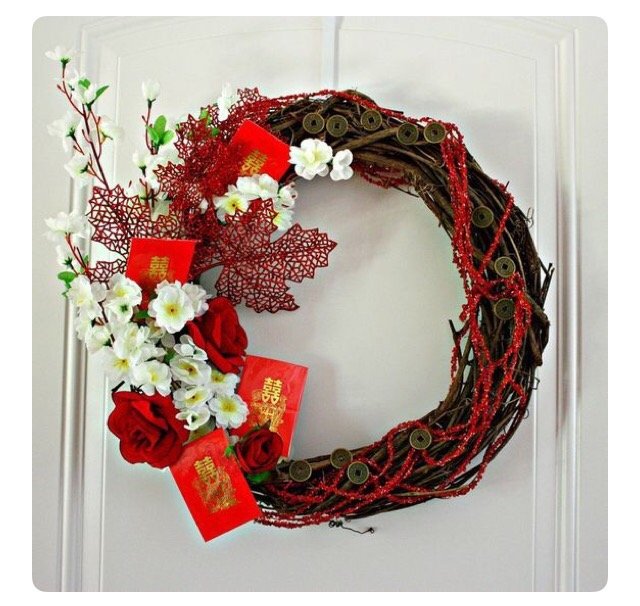
by Sophie Lee 李淑儀 | Feb 11, 2018 | Parenting

Do you get a little panic when your friends or relatives give food to your little ones without asking for your consent? In my opinion, I would say it is absolutely acceptable to politely remind your friends and relatives about your little ones’ food allergies and your personal preference of “please ask me before giving food to my child”.
Here is a list of festive snacks that adults cannot resist but not necessarily healthy snacks for children:
Flavoured dried plums
The tasteful flavoured dried plums are irrisistible (for adults). Did you know that it is actually made of lots of artificial flavoring and preservatives? Take a look at the ingredients list and I’m sure you can find very little natural ingredients.
It is bad for children as children’s detoxification system is yet to be mature. Moreover, children might risk swallowing the small seeds, a serious choking hazard.
Salted vegetables & dried meat related products
The high sodium content in this category of festive food can easy surpass one’s daily recommended sodium intake. Marinated food products are often packed with nitrite, aflatoxin and benzopyrene, that are the main cancer causing culprits.
Nuts & Seeds
Many parents might assume that as long as children have a mouthful of teeth, they should be able to safely consume nuts and seeds. In fact, children below 3 years old have yet to fully developed their chewing and swallowing skills, therefore they might not be able to productively chew the nuts and seeds into a digestible form. In rare cases, children suffer from choking hazard especially when they are eating while playing.
Honey
Honey is not suitable for toddler below 1 years old due to the risk of Botulism. Botulism is a rare and potentially fatal illness caused by a toxin produced by the bacterium Clostridium botulinum. The disease begins with weakness, blurred vision, feeling tired, and trouble speaking.
Jelly
The colourful and tasteful jelly is another artificial food that you should not be giving to your children. Not only that it contains little or none nutritional values, it is also one of the common choking hazard.
Alcohol
It’s absolutely not all right to have a two-year-old sipping wine and beer, it provides absolutely no benefit to the child and it can be quite harmful.
Alcohol has very specific effects on the body that can be particularly harmful to a child. It causes the blood sugar to fall to levels that can cause irritability, confusion, and even seizures. It lowers the body temperature, and since children’s bodies have such a large surface area relative to their weight, they lose heat rapidly and can become hypothermic very easily. Additionally, alcohol has very direct effects on the brain. Since most of a person’s brain growth occurs during the first few years of life, repeated exposure to alcohol could interfere with brain growth and cause delayed development and lowered intelligence.
Ginkgo
Ginkgo is known for containing a small amount of toxin, more if consumed uncooked. However if a child consumes uncooked ginkgo, the risk of food poisoning and fatality is much higher than adults.
Coffee
Caffeine in coffee may hinder children’s brain and bone development. Who needs an even more hyper child when your child is already active without caffeine?
Glutinous Rice Balls, Rice Cakes
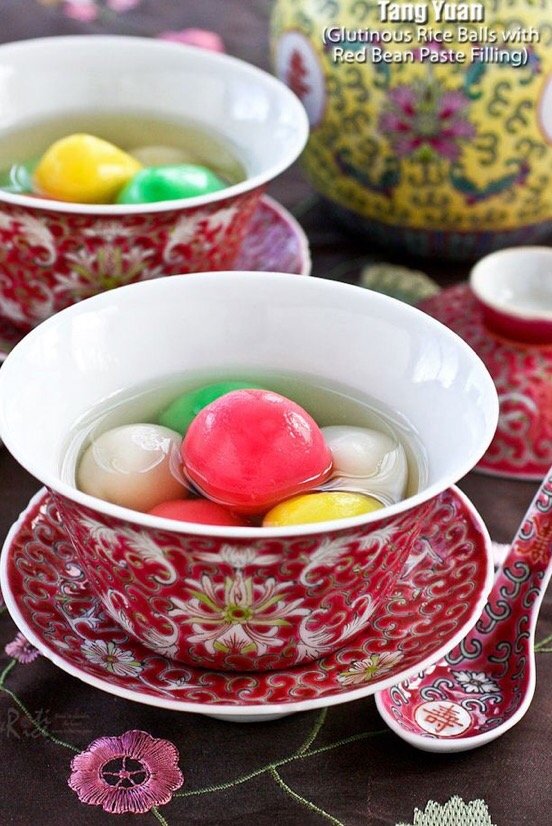
The main ingredient for this festive snack is glutinous rice. Although it is a relatively healthy option, but children’s delicate digestive system may not be able to handle them well yet. Overeating this category of snacks will cause bloated stomach, nausea and poor digestion. Definitely not recommended for toddler below 3 years old.
Sashimi, medium rare beef, alcohol-cooked seafood etc
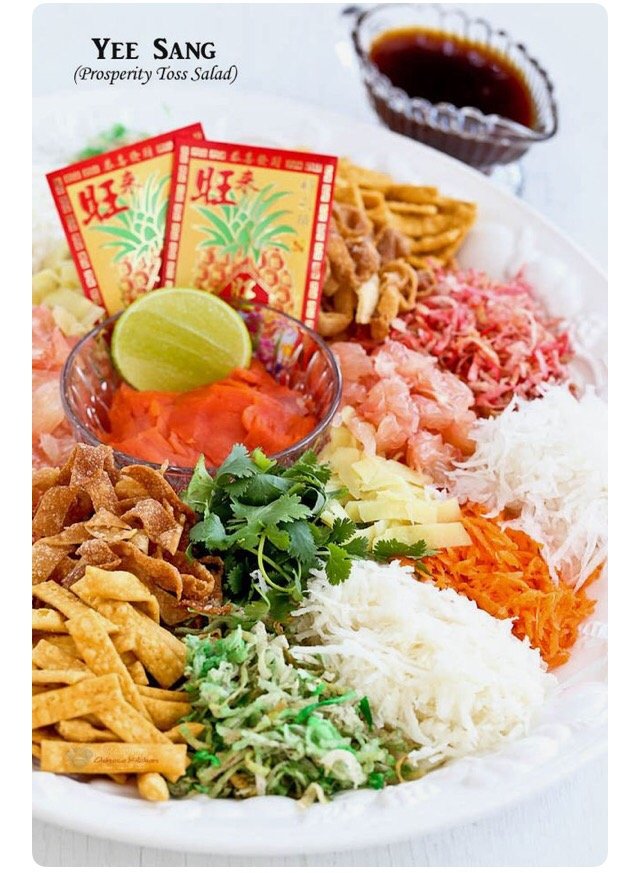
Most of the sashimi slices on top of the Yee Sang are not hygienically prepared, so you can imagine the risk level of food poisoning, especially for those with poor digestive system and children.
Children do not have a mature digestive system to protect them against food-borne disease.
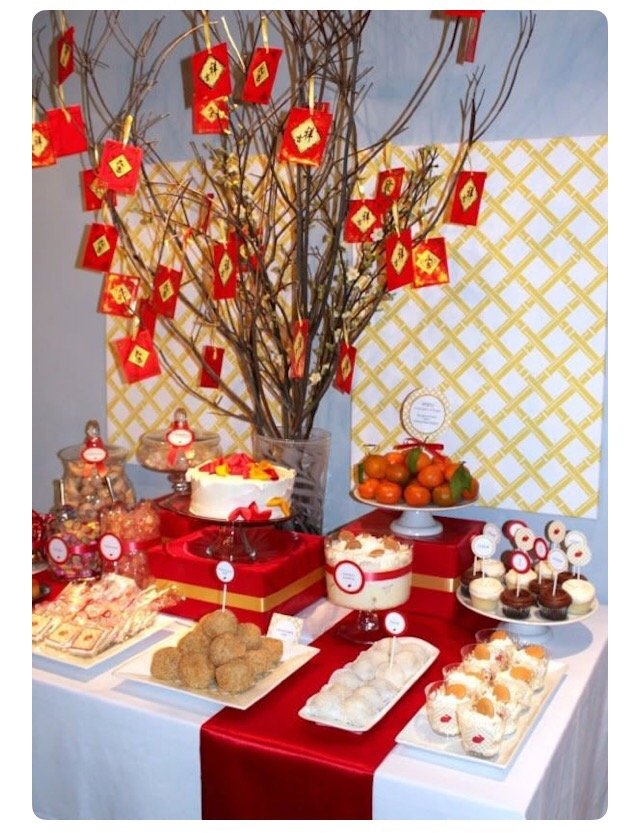
What should you be doing?
Keep an eye on them
Better be safe than sorry. Remind your children if they have any food allergies, give gentle reminders to your friends and family on your take of giving food to children.
Emergency Assistance
Seek immediate medical assistance if needed. Better be safe than sorry!
Know your limits
It is impossible to ban your children to snack on every single type of less healthy snacks. Set your limit and educate your children to consume these snacks responsibly and sensibly. After all, the big part of CNY is food sharing, right?

by Sophie Lee 李淑儀 | Feb 8, 2018 | Events, Parenting
学龄前孩子在新年期间,听到舞狮团敲锣打鼓!由于年纪小,小朋友即害怕又期待,想看又紧张!五味杂成的心情,爸爸妈妈了解吗?


这些年的观察与体验,看到小朋友紧张地观察这个庞然大物,不知所措……终于嚇哭的心情!
于是我们设计课程,首先介绍狮头的各部分名称:
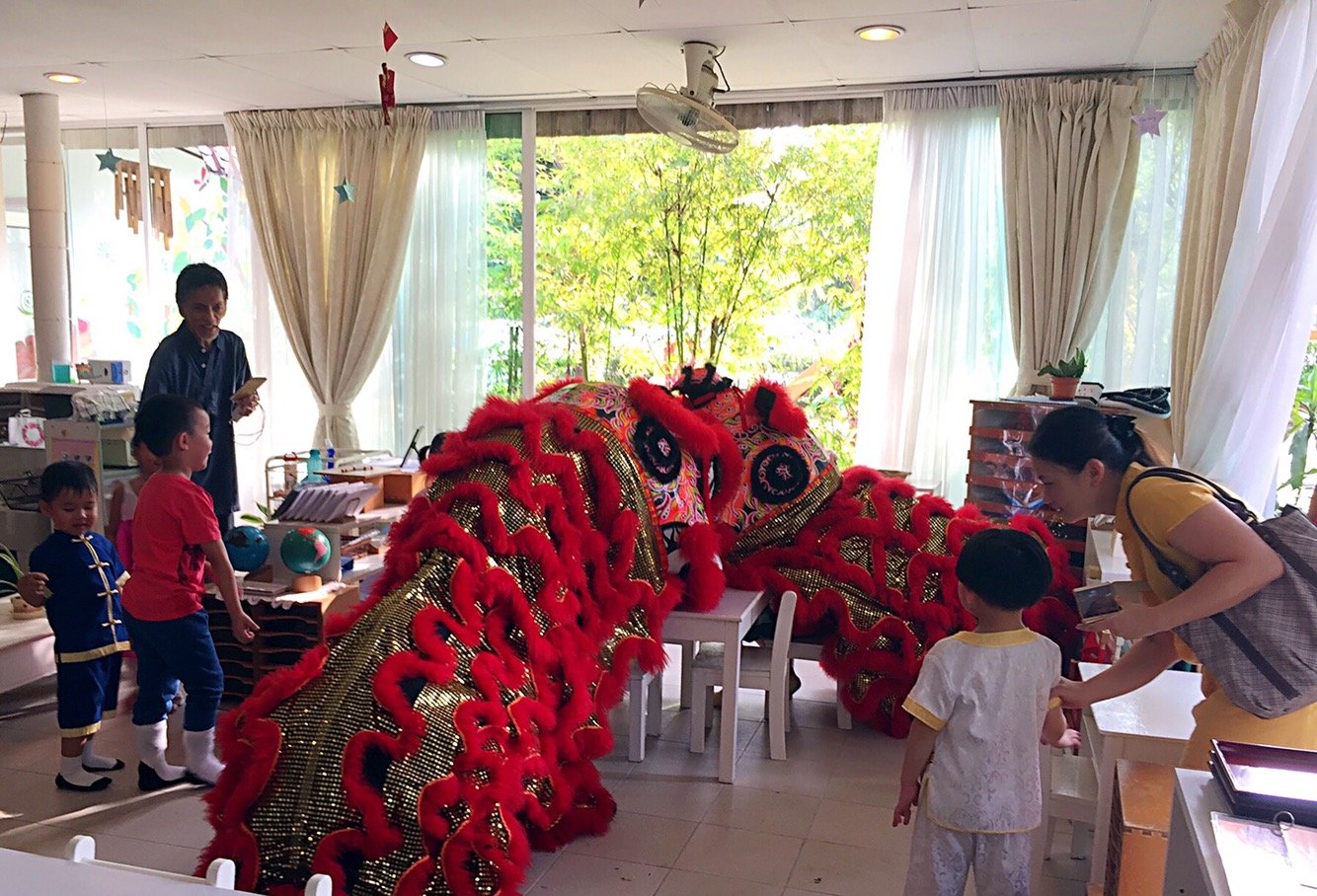
从会贬的眼睛开始摸,再看到两眼中间的独角,大大的嘴巴可以伸出手来分享橘子🍊或者金币,再沿着狮子的身体摸到狮尾,感受一片一片的鳞片。

接着我们再介绍乐器,先让鼓队打鼓,再响锣、用小棒子敲钹,完成介绍乐器各部分名称后再组合起来,从小声量到大声量,最后一片锣鼓响满天!让孩子们体会热热闹闹的开心气氛。
这些年的观察经验,发现到小朋友最后都爱上了狮子,热情地在狮子边跑来跑去。

再与舞狮团队挥别的当儿,还依依不舍……
欢迎到绿茵或绿野蒙特梭利学校参与循序渐进、按歩就班班的文化体验。
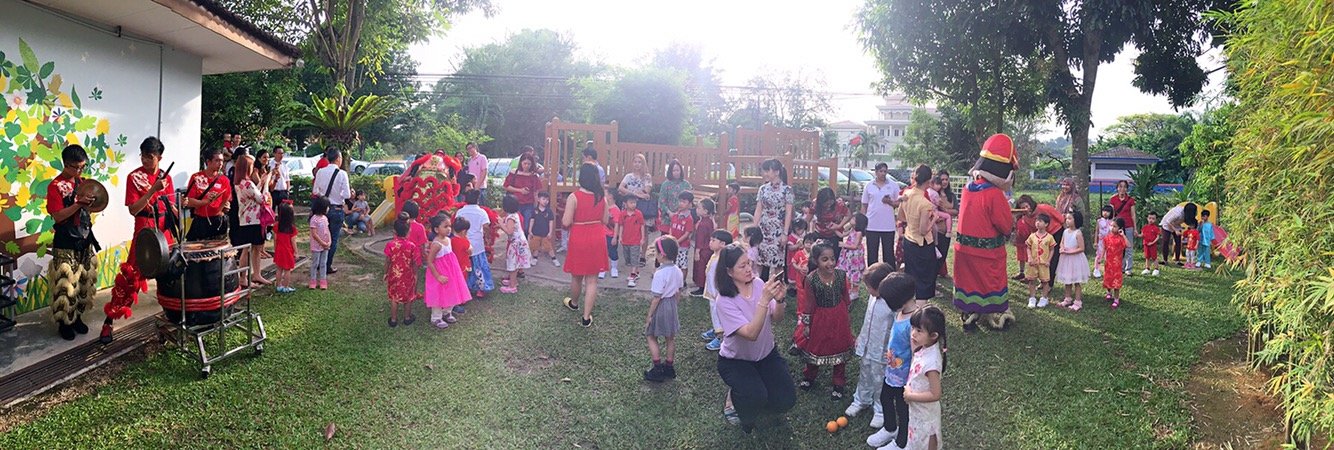

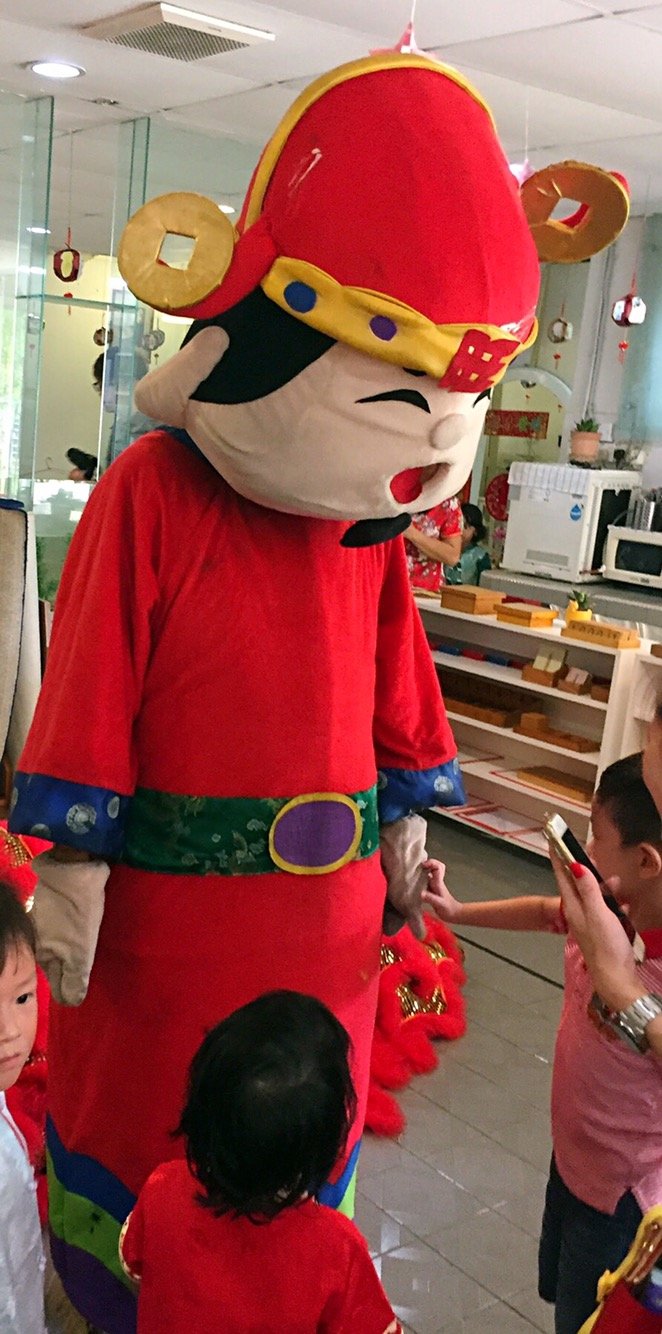
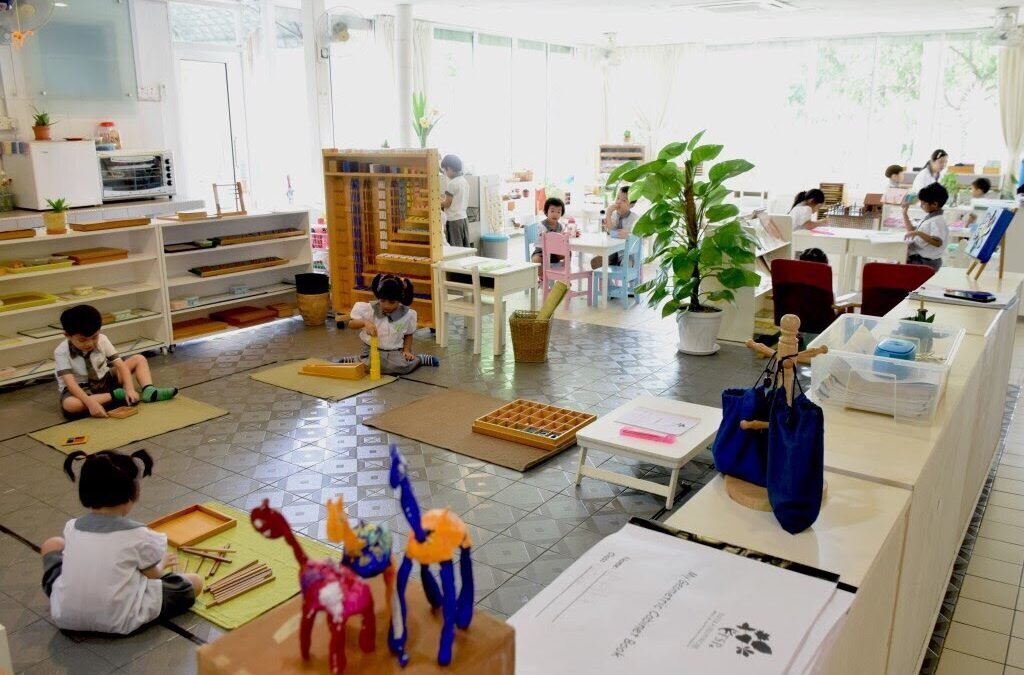
by Sophie Lee 李淑儀 | Feb 4, 2018 | Montessori Learning
A PEAK INSIDE THE MONTESSORI CLASSROOM:
How can children learn in a mixed-aged classroom? Would it be rather difficult for a teacher to take care of my child’s learning progress in the classroom? I couldn’t imagine how can my child learn better in a classroom with mix ages! As a new Montessori practitioner, I could still remember all these questions popped from my mind when I was still in my college, studying the philosophy behind Montessori’s pedagogy. The concept of mix-aged group in a classroom happens to be common around the world. However, how do we know if it is efficient for children’s learning?
If we study the philosophy of Montessori’s educational approach, teachers are well-trained being the “eye” of the classroom. They need to have the ability observing every single detail from children’s developmental growth, to a little small pot of plant at the corner of the classroom. Here I am, lucky enough to have the luxury observing how does a Montessori classroom look like.

Imagine our working environment as adults, do you work only with people who are the same age as you are? Definitely NOT! This is the main idea, we create a MINI SOCIETY for the children to learn from peers! Physically, you might see the children are growing differently, in fact, they are different in all ways, no matter cognitively, socially, emotionally and development of their language. We always learn from those who share different strengths that we might not acquire yet, this goes the same to the children. Their need to learn can be met by interacting with different age groups!
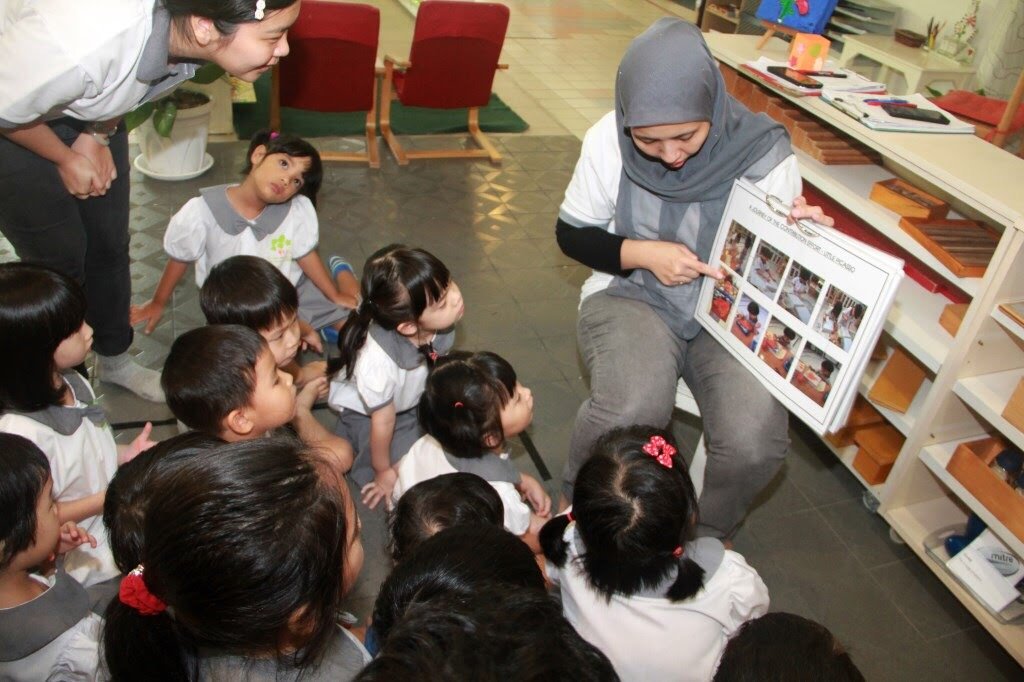
Other than that, in this ‘mini-society’, children learn to respect and response with grace and courtesy. For example, each child will learn to clear his/her workspace after completing their work. What does the child learn? Cleaning the place? NOT ONLY THAT. Children will learn that they need to respect the environment by taking care of the classroom, they will also learn that space is shared among everyone in the classroom. The younger children learn the rules; the older children have a deeper understanding of the reason behind the rules. Therefore, older children will be the guidance, the role model that lead the younger children to learn better in many ways. The older children will develop many positive values while helping the younger children to grow. They will learn to communicate according to the level of younger children’s understanding. I have seen a six-year-old child tried so hard to make a three-year-old child understand the way to paste a strip of paper on her book. She tried to explain verbally at first, but it did not work. Then, she found a way to help her by pasting her own strip in front of her. See that? It’s not only about learning skills, but how the child took the initiative to help and support the younger child.
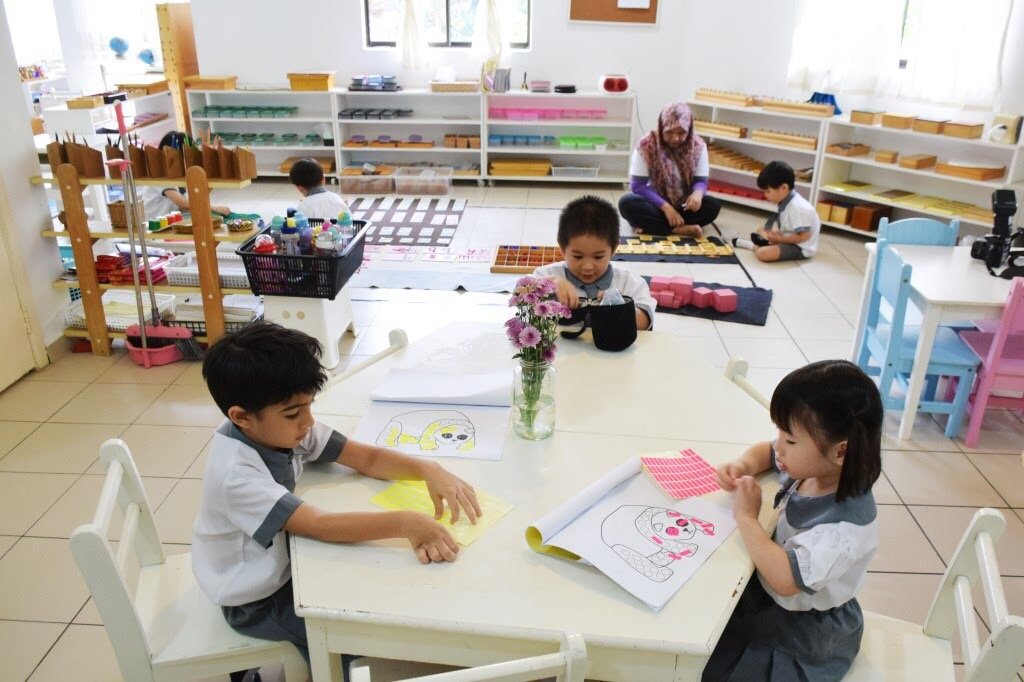
Younger children learn by observing the older children in the classroom. If you have come across with the theory of zone of proximal development(ZPD) by Lev Vygotsky, children in their ZPD need support and aid to acquire new knowledge/skills. Hence, scaffolding is one of the most efficient ways that a teacher or a more competent classmate will do to aid a child’s learning. For example, if a child is competent working with embroidery, he/she can show the child who might be new to embroidery. Imagine if you have twenty children in the classroom, you will observe twenty individuals with different strengths and personalities. They all learn among each other by working together with respect and care. Thus, it never about the age, but the way they learn from each other. I have been asked if teachers are able to take care of all children in the classroom equally with the concept of mixed-ages in the classroom. Well, as educators, we have the responsibility to observe, to plan and to support children’s individual learning. (Yes, don’t worry, we are trained to do that every single day!)
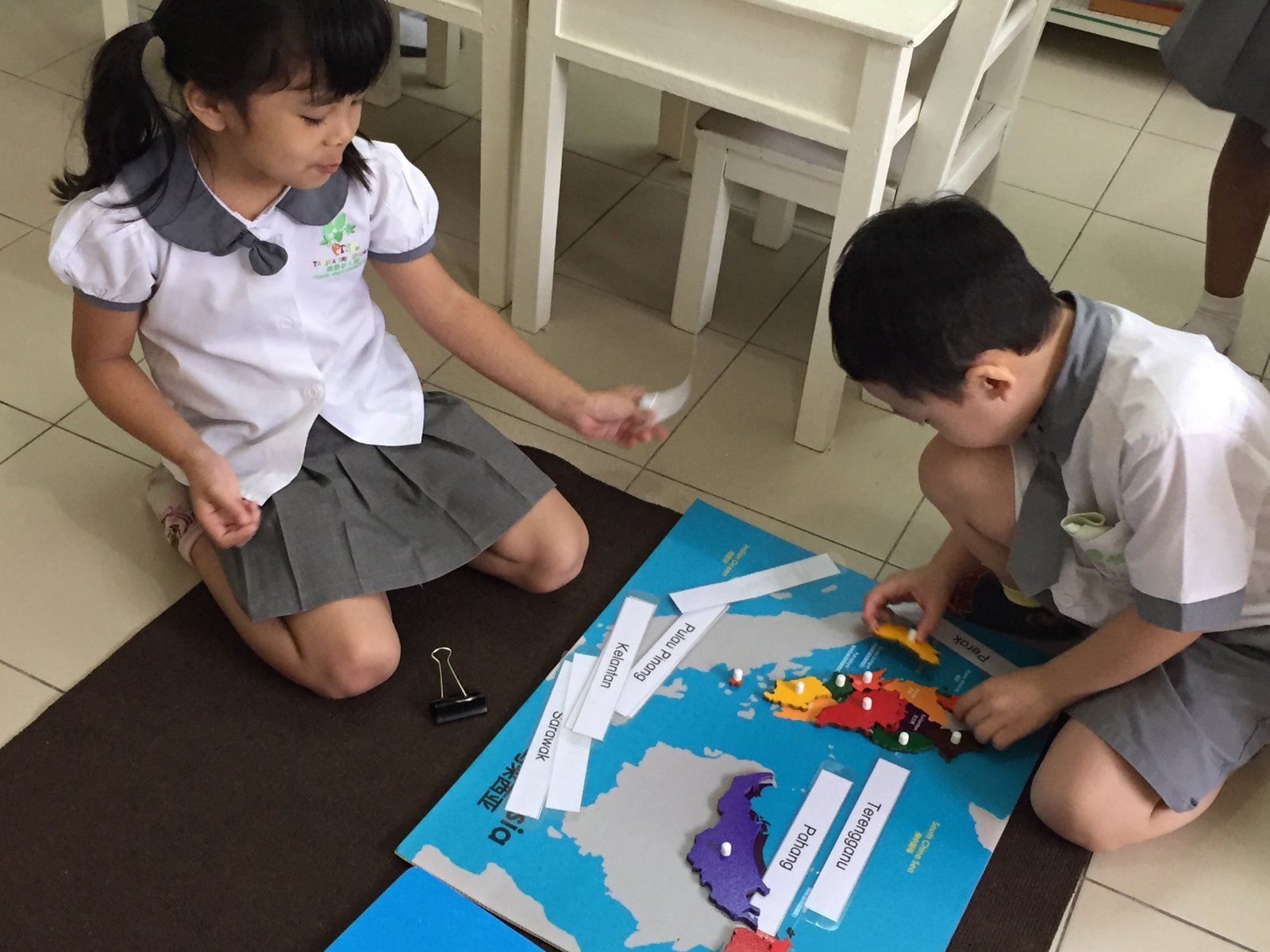
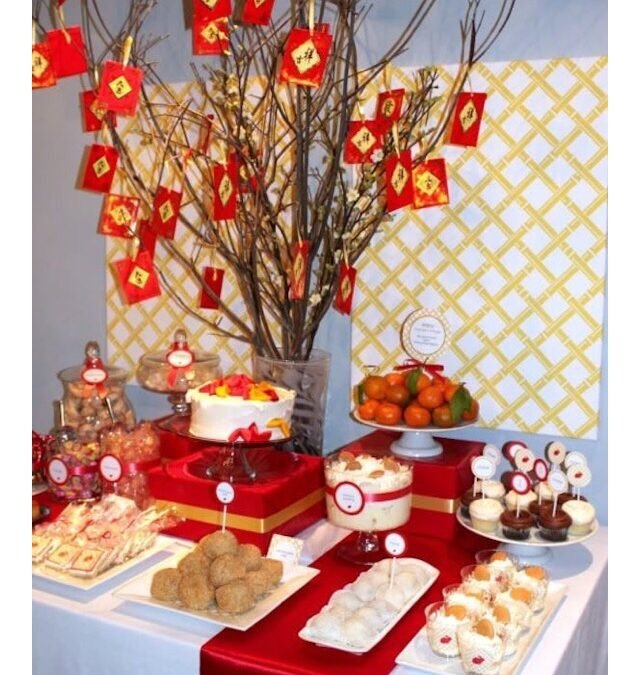
by Sophie Lee 李淑儀 | Jan 29, 2018 | Parenting

过年期间带小朋友参加各种饭局聚会,难免会有亲戚朋友把各种能吃的不能吃的都往自己家的小朋友嘴里塞。需知小朋友还小,有的东西不能吃,有的会过敏,有的消化不了。我的经验是,提前打招呼,温和且坚定地告亲戚朋友不要给孩子吃东西,当然还是无法避免一些亲戚继续无所谓、依然故我地喂,爸爸妈妈要做的就是时刻盯紧,看到他们忍不住与孩子分享时,当场制止。
以下食物逢年过节家中常备,成人过年解馋的零食,却不能喂小宝宝吃!对孩子的健康造成威胁,父母应时刻警惕孩子误食和亲戚喂食。
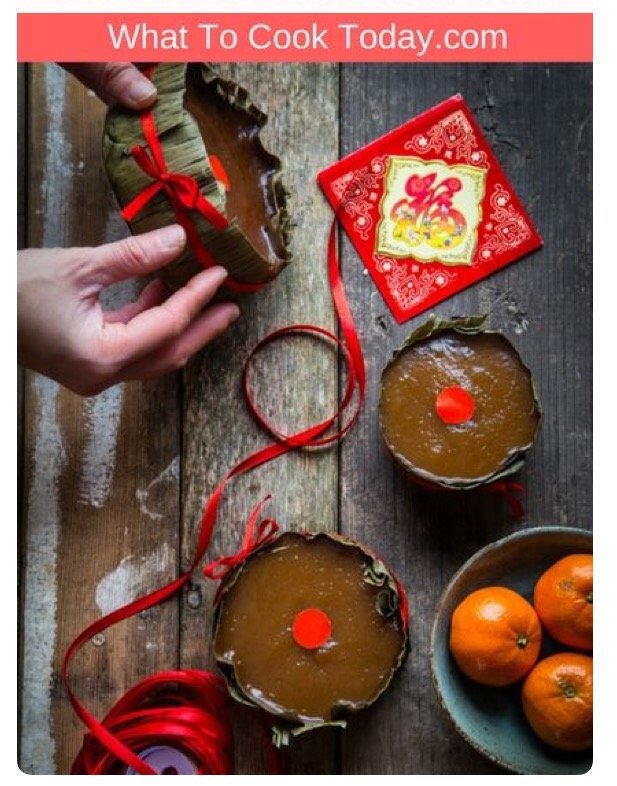
1、话梅、蜜饯:
话梅肉让很多人“爱不释口”,其实这种蜜饯类食品几乎是各种添加剂的大集合!看看它的配料表就知道了:鲜杏肉,白砂糖,食盐,奶油,柠檬酸,甜菊糖苷,阿斯巴甜,甜蜜素,甘草,香兰素,乙基麦芽酚,山梨酸钾,糖精钠,安赛蜜,苯甲酸钠。
小朋友的解毒功能很弱,如果再加上饮料和其他食品中的类似添加剂,难免添加剂的总量过高。而且小宝宝还太小,话梅有核,宝宝吃了根本就不会吐出来,只要卡住就会造成生命危险。
2、咸菜、腌制食品:
过年过节特别喜欢腌制各种咸菜、肉类,而且在腌制过程中会放很多盐。高盐饮食易诱发高血压病;腌制品中含有大量的亚硝酸盐,它和黄曲霉素、苯丙芘是世界上公认的三大致癌物质。所以,像咸菜、腌肉、培根、鱼片、牛肉干、鱿鱼丝这类食品,尽量不要给宝宝吃。
3、花生、瓜子、坚果:
很多家长会觉得宝宝长牙了、能咬了就可以吃坚果了。但实际上3岁以下的小宝宝不易嚼碎坚果,而且吞咽反射还未发育完善,即使能咬动坚果,也不能充分咀嚼,大颗粒仍然容易卡住气管。而且堵住气管后若抢救不当,短短几分钟就可能丧命。
尤其像夏威夷果、开心果这种圆形的坚果,宝宝吃在嘴里时,大人一逗笑,就更容易滑进气管里。
4、蜂蜜:
蜂蜜中往往混有肉毒杆菌孢子,由于婴儿肠道菌群防御力有限,肉毒杆菌孢子可能会在肠道中发芽并释放毒素,导致肉毒杆菌中毒,造成便秘、食欲不振、虚弱、哭声改变和口、眼等不听使唤。世界卫生组织建议,1岁以下宝宝不适合吃蜂蜜。
5、果冻:
这玩意儿虽小,且五彩缤纷、香甜滑爽,但含很多添加剂,尤其人工色素,宝宝长久食用会导致反应迟钝、智力下降。另外,老人和小孩吞食果冻容易发生意外 。果冻上面都有提示,3岁以下孩子不适合吃。
6、白果(银杏):
很多人知道白果有轻微毒性,但是小宝宝食用白果,比成年人更加容易导致中毒,而且年龄越小死亡率越高。如果食用的白果是自家熟制或用微波炉烘烤,极有可能只有七八分熟。生白果的毒性比熟白果的毒性更强,几颗就可能引发中毒。
7、酒:
虽然儿童喝酒不一定都会导致中毒,但危害是很大的,尤其是7岁以下的孩子。由于肝脏还未发育成熟,肝对酒精的解毒能力相对较差,如果饮酒可能会损伤肝,很容易就过量,出现昏迷等重症,3岁以下的宝宝伤害更大,严重的话还会造成脑损伤或死亡。
8、咖啡
不能给小朋友喝咖啡,因为咖啡内含有大量的咖啡因及茶碱,、阻碍婴儿骨骼发育。
不利于健康及大脑发育, 这些物质会刺激大脑,导致孩子过度兴奋,出现成瘾性和引发多动症。
9、汤圆、年糕:

很多地方过年有吃年糕和汤圆的习俗。但年糕一般都是糯米做的,一方面糯米不好消化,可能会加重宝宝胃部的负担。
另外,糯米这种食物还可能加剧宝宝胃酸的反应,会造成宝宝胃部不舒服。而且糯米很黏,宝宝很容易吞咽不下去而发生危险。因此, 不建议3岁以下宝宝吃年糕或汤圆。
10、鱼生、半熟牛排、醉蟹、醉虾、生田鸡:

很多生鱼片、魚生的卫生皆不过关,其中含有大量的病菌,在调料中蘸一下几乎没什么杀菌作用,孩子的消化道很娇弱,很容易就造成腹泻、胃肠感冒等症状,一些鱼生、没有煮熟的鱼(特别是淡水鱼)、半熟的牛肉、生虾蟹、田鸡內可能还有寄生虫,是酒精、芥末、调料根本杀不掉的!
因为好吃生食而导致全身长满寄生虫的案例比比皆是,成人也就罢了,儿童感染寄生虫,严重时可能会影响生长和智力发育。

家长怎么做?
1.盯紧
除了告诉孩子哪些东西不能吃外,该打招呼的也要打招呼,该盯紧的盯紧,面子事小,孩子事大,尤其是事关孩子安全的问题,该拒绝的一定要有礼貌的拒绝,等悲剧发生什么都晚了。
2.急救
紧急情况应联系送医。
如果是小孩被噎,家长应在联系送医的同时尽快自行施救。
3.有些食物可适当妥协
当然,除了以上几种食物外,还有不胜枚举的垃圾食品,比如薯条、可乐、薯片等等,吃了对小朋友身体一点好处没有,但过年期间,家里难免有亲戚朋友来串门,喂一口在所难免,家长不必刻意阻挠,在做不到严防死守的情况下,我们可以控制好宝宝的食用量,保证全家人过一个欢乐祥和、健康平安的新年。


 团圆是春节的主题,无论相隔多远的距离,亲朋好友都会团聚在一起,在这个节日里,我们的宝贝会接触到很多的亲朋好友,而幼儿的社会性礼仪发展,正是在人与人之间相互沟通和交流中建立起来的,所以,不妨利用春节假期,对孩子进行一场“静悄悄”的礼仪教育,让孩子在潜移默化中获得成长。
团圆是春节的主题,无论相隔多远的距离,亲朋好友都会团聚在一起,在这个节日里,我们的宝贝会接触到很多的亲朋好友,而幼儿的社会性礼仪发展,正是在人与人之间相互沟通和交流中建立起来的,所以,不妨利用春节假期,对孩子进行一场“静悄悄”的礼仪教育,让孩子在潜移默化中获得成长。